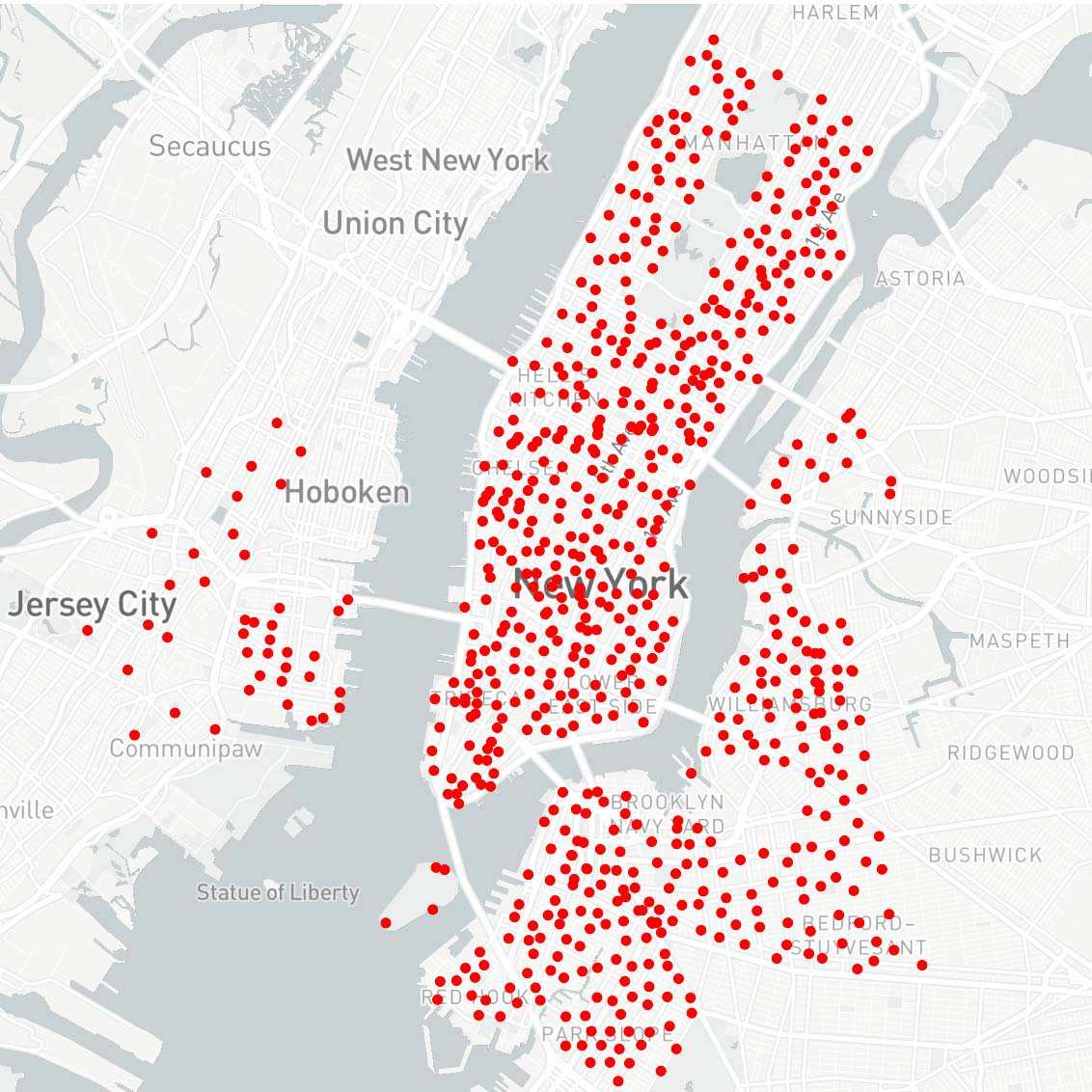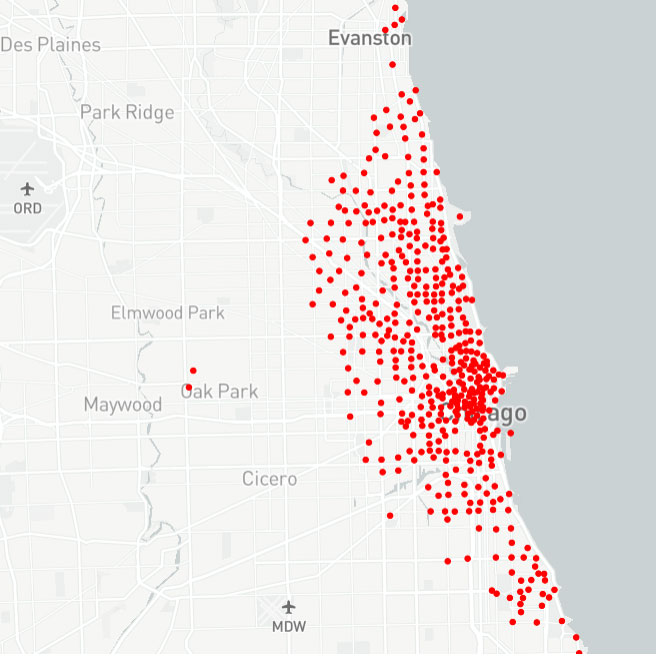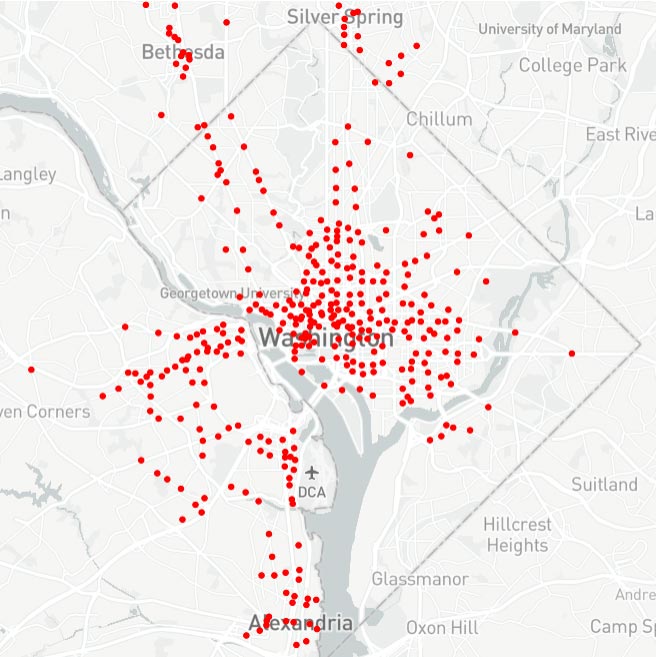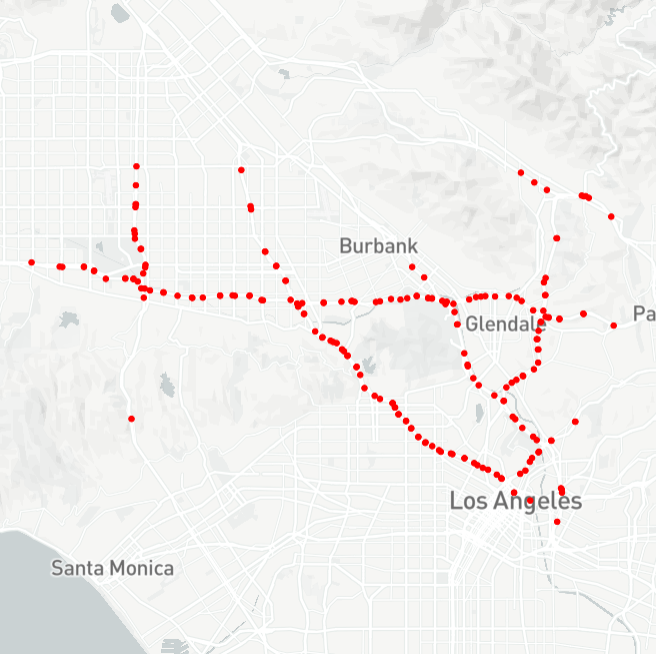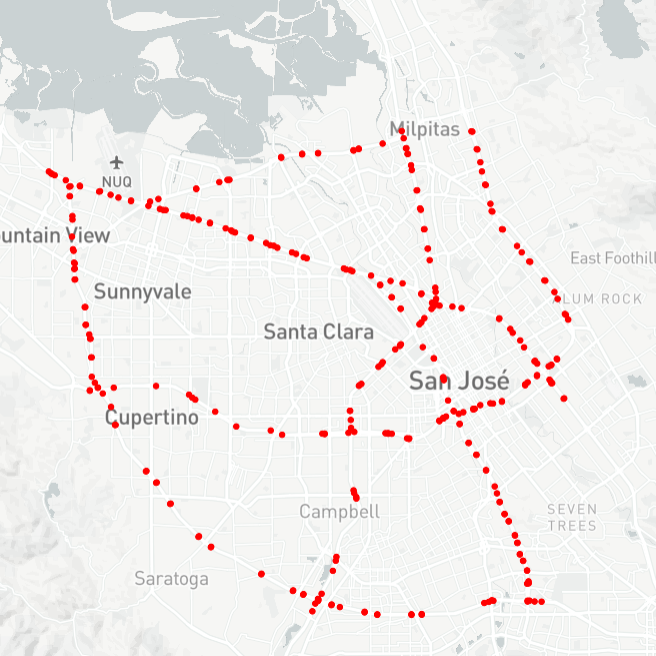Currently, UCTB offers the following datasets in 7 scenarios, with detailed information provided in the table below. We are constantly working to release more datasets in the future.
| Application | City | Time Span | Interval | Link |
|---|---|---|---|---|
| Bike-sharing | NYC | 2013.07.01-2017.09.30 | 5 & 60 mins | 5 mins 60 mins |
| Bike-sharing | Chicago | 2013.07.01-2017.09.30 | 5 & 60 mins | 5 mins 60 mins |
| Bike-sharing | DC | 2013.07.01-2017.09.30 | 5 & 60 mins | 5 mins 60 mins |
| Bus | NYC | 2022.02.01-2024.01.13 | 60 mins | 60 mins |
| Vehicle Speed | LA | 2012.03.01-2012.06.28 | 5 mins | 5 mins |
| Vehicle Speed | BAY | 2017.01.01-2017.07.01 | 5 mins | 5 mins |
| Pedestrian Count | Melbourne | 2021.01.01-2022.11.01 | 60 mins | 60 mins |
| Ride-sharing | Chicago (community) | 2013.01.01-2018.01.01 | 15 mins | 15 mins |
| Ride-sharing | Chicago (census tract) | 2013.01.01-2018.01.01 | 15 mins | 15 mins |
| Ride-sharing | NYC | 2009.01.01-2023.06.01 | 5 mins | 5 mins |
| Metro | NYC | 2022.02.01-2023.12.21 | 60 mins | 60 mins |
| Traffic Flow | Luzern | 2015.01.01-2016.01.01 | 3 mins | 3 mins |
| Traffic Flow | Hamburg | 2016.08.27-2016.12.09 | 3 mins | 3 mins |
The bike-sharing datasets are collected from U.S. open data portals including New York City (NYC, https://www.citibikenyc.com/system-data), Chicago (CHI, https://www.divvybikes.com/system-data), and DC (https://www.capitalbikeshare.com/system-data). The dataset time span for all three cities is more than four years. The total number of historical flow records is around 49 million, 13 million, and 14 million in NYC, Chicago, and DC, respectively, and each record contains the start station, start time, stop station, stop time, etc.
The following shows the map visualization of bike stations in NYC, Chicago, and DC.
Data catalog: https://github.com/uctb/Urban-Dataset/tree/main/Public_Datasets/Bike/
| 5-minutes | New York City | Chicago | DC |
|---|---|---|---|
| TimeRange | 2013.07.01-2017.09.30 | 2013.07.01-2017.09.30 | 2013.07.01-2017.09.30 |
| TimeFitness | 5 mins | 5 mins | 5 mins |
| TrafficNode.shape | (446976, 820) | (446976, 585) | (446976, 532) |
| StationInfo.shape | [820, 5] | [585, 5] | [532, 5] |
| TrafficGrid.shape | (446976, 20, 20) | (446976, 20, 20) | (446976, 20, 20) |
| GridLatLng.shape | [21, 2] | [21, 2] | [21, 2] |
| Size | 66.0M | 30.2M | 31.0M |
| 60-minutes | New York City | Chicago | DC |
|---|---|---|---|
| TimeRange | 2013.07.01-2017.09.30 | 2013.07.01-2017.09.30 | 2013.07.01-2017.09.30 |
| TimeFitness | 60 mins | 60 mins | 60 mins |
| TrafficNode.shape | (37248, 820) | (37248, 585) | (37248, 532) |
| StationInfo.shape | [820, 5] | [585, 5] | [532, 5] |
| TrafficGrid.shape | (37248, 20, 20) | (37248, 20, 20) | (37248, 20, 20) |
| GridLatLng.shape | [21, 2] | [21, 2] | [21, 2] |
| download | 20.5M | 11.0M | 10.7M |
The bus datasets are collected from DATA.NY.GOV: MTA Bus Hourly Ridership. This dataset is provided by the Metropolitan Transportation Authority and is available for public download. It offers bus ridership estimates on an hourly basis by bus route. Data collection started from February 2022 and has been regularly updated. The Bus_NYC dataset includes data up to January 13, 2024. The latest version can be accessed on the website mentioned above. The station info data is downloaded from NYU | Faculty Digital Archive: New York City Bus Routes, Dec 2019. It does not encompass all bus routes. So we discarded the traffic data for bus routes where station information was not found, ultimately retaining 226 bus routes.
Following shows the map-visualization of Bus_NYC datasets.
Data catalog: https://github.com/uctb/Urban-Dataset/tree/main/Public_Datasets/Bus
| 60-minutes | New York City |
|---|---|
| TimeRange | 2022.02.01-2024.01.13 |
| TimeFitness | 60 mins |
| TrafficNode.shape | (17064, 226) |
| StationInfo.shape | [226, 5] |
| TrafficGrid.shape | (0) |
| GridLatLng.shape | [0] |
| download | 4.9M |
The two traffic speed datasets are widely used in STTP research: METR-LA and PEMS-BAY from Los Angeles (LA) County and Bay Area, respectively. In METR-LA, 207 sensors record highway vehicles’ speeds for four months; In PEMS-BAY, there are 325 sensors for six months. Each sensor can be seen as a station.
Following shows the map-visualization of METR-LA and PEMS-BAY.
Data catalog: https://github.com/uctb/Urban-Dataset/tree/main/Public_Datasets/Speed/
| 5-minutes | METR_LA | PEMS_BAY |
|---|---|---|
| TimeRange | 2012.03.01-2012.06.28 | 2017.01.01-2017.07.01 |
| TimeFitness | 5 mins | 5 mins |
| TrafficNode.shape | (34272, 207) | (52128, 325) |
| StationInfo.shape | [207,5] | [325,5] |
| TrafficGrid.shape | (0) | (0) |
| GridLatLng.shape | [0] | [0] |
| Size | 11.8M | 27.9M |
The pedestrian datasets are collected from open data website of Melbourne. The full datasets' timespan is over 10 years and the datasets are still being updated at a fixed frequency (i.e., 60 minutes). Due to the fact that some sites were not set up in the early days and some sites lacked data, we only choose about a year in temporal dimension and 55 stations in spatial dimension. There is also accessible information about sensors on the same website. In the dataset of sensor information, we obtain the name, the sensor's ID, the sensor's status(whether it is active or not), the latitude and longtitude of each sensor.
Following shows the map-visualization of Pedestrian datasets in Melbourne.
Data catalog: https://github.com/uctb/Urban-Dataset/tree/main/Public_Datasets/Pedestrian
| 60-minutes | Pedestrain Melbourne |
|---|---|
| TimeRange | 2021.01.01-2022.11.01 |
| TimeFitness | 60 mins |
| TrafficNode.shape | (16056, 55) |
| StationInfo.shape | [55,5] |
| TrafficGrid.shape | (0) |
| GridLatLng.shape | [0] |
| Size | 1.18M |
The Taxi datasets are collected from the city of Chicago's open data portal and the city of New York's open data portal, where you are able to freely download Chicago city's and NYC's datasets for your own analysis. The datasets record taxi trips from these dimensions listed below: pickup and dropoff time, pickup and dropoff location, fee etc. In our dataset, we only consider the pickup info of each record. You can conduct more comprehensive analysis with the help of our datasets and the website.
Facts in dataset description
- There are two candidate spatial discretization information: census tract and community area.
- For each record, it will aggregate census tract granularity into community area due to privacy preserve.
Which granularity to choose
Thus, we need to choose a proper granularity. According to the needs of downstream tasks (Spatio-temporal traffic prediction), we summarize two principles of spatial granularity selection:
- Spatial granularity as small as possible (especially in high-demand area).
- Demamd aggregated due to privacy as few as possible.
On one hand, time distribution of taxi demand in downtown is dense, and the probability of being aggregated is small. on the other hand, the time distribution of taxi demand in the suburbs is sparse, and the probability of being aggregated is high.
Final datasets we open
We finally choose to process two datasets: one is Taxi_Chicago, where only spatial granularity community area is used; another is Taxi_fine_grained_Chicago, where community area is used in suburbs while census tract is used in downtown.
We highly recommend that you conduct more analysis on Taxi_fine_grained_Chicago. By the way, we have adopted a special operation that taxi demand of specific census tract in 15-minute time window equal or less than 2 will be set 2. This operation won't affect much because all of aggregation situation is ultimately caused by insufficient demand.
Following shows the map-visualization of Taxi_Chicago datasets.
Following shows the map-visualization of Taxi_fine_grained_Chicago datasets.
We collect Taxi NYC dataset from these two websites: https://opendata.cityofnewyork.us/ and https://www.nyc.gov/site/tlc/about/tlc-trip-record-data.page. We also obtain information of taxi zones in New York from this website. As a result of size of dataset, we put it on the link with extraction code gw6p.
Following shows the map-visualization of Taxi_NYC datasets.
Data catalog: https://github.com/uctb/Urban-Dataset/tree/main/Public_Datasets/Taxi
| Taxi-Demand | Taxi_Chicago | Taxi_fine_grained_Chicago | Taxi_NYC |
|---|---|---|---|
| TimeRange | 2013.01.01-2018.01.01 | 2013.01.01-2018.01.01 | 2009.01.01-2023.06.01 |
| TimeFitness | 15 mins | 15 mins | 5 mins |
| TrafficNode.shape | (175296, 77) | (175296, 121) | (1516032, 263) |
| StationInfo.shape | [77,5] | [121,5] | [263,5] |
| TrafficGrid.shape | (0) | (0) | (0) |
| GridLatLng.shape | [0] | [0] | [0] |
| Size | 6.06M | 10.0M | 208.7M |
The metro datasets are collected from DATA.NY.GOV: MTA Subway Hourly Ridership. The Metro_NYC dataset is provided by the Metropolitan Transportation Authority and is available for public download. It offers estimates of subway ridership on an hourly basis by subway station complex. Data collection started from February 2022 and has been regularly updated. The Metro_NYC dataset includes data up to December 21, 2023. The latest version can be accessed on the website mentioned above.
Following shows the map-visualization of station complex in NYC.
Data catalog: https://github.com/uctb/Urban-Dataset/tree/main/Public_Datasets/Metro
| 60-minutes | New York City |
|---|---|
| TimeRange | 2022.02.01-2023.12.21 |
| TimeFitness | 60 mins |
| TrafficNode.shape | (16512, 426) |
| StationInfo.shape | [426, 5] |
| TrafficGrid.shape | (0) |
| GridLatLng.shape | [0] |
| download | 11.9M |
The traffic flow datasets are collected from UTD19 - Research Collection. UTD19 is a large-scale traffic data set from over 20000 stationary detectors on urban roads in 40 cities worldwide making it the largest multi-city traffic data set publically available. In our dataset, we only consider the data for the city of Luzern, Switzerland and Hamburg, Germany. The dataset enriched location information of sensors with further attributes describing the location of the sensor with respect to the road network. Note that the shape[1] of the StationInfo in Hamburg is 6, instead of 5 in other datasets. The additional column is the road each sensor belongs to.
Following shows the map-visualization of station complex in Luzern and Hamburg.
Data catalog: https://github.com/uctb/Urban-Dataset/tree/main/Public_Datasets/Flow
| 3-minutes | Luzern | Hamburg |
|---|---|---|
| TimeRange | 2015.01.01-2016.01.01 | 2016.08.27-2016.12.09 |
| TimeFitness | 3 mins | 3 mins |
| TrafficNode.shape | (175200, 140) | (49920, 392) |
| StationInfo.shape | [23626, 5] | [392, 6] |
| TrafficGrid.shape | (0) | (0) |
| GridLatLng.shape | [0] | [0] |
| download | 20.9M | 14.8M |
We've collected some public datasets and processing them into UCTB dataset format. UCTB dataset is a python build-in dictionary object that could be loaded by pickle package. Here is the example of UCTB dataset.
UCTB_dataset = {
"TimeRange": ['YYYY-MM-DD', 'YYYY-MM-DD'], # time span of datasets (e.g., 2013.07.01-2017.09.30)
"TimeFitness": 60, # Minutes
"Node": { # Designed for GNNs models, it is a dictionary that stores traffic data.
"TrafficNode": np.array, # With shape [time, num-of-node]
"StationInfo": list # elements in it should be [id, build-time, lat, lng, name]
},
"Grid": { # Designed for CNNs models, it is a dictionary that stores Grid data.
"TrafficGrid": [], np.array, # With shape [time, num_rows, num_cols]
"GridLatLng": [], list # It stores the geographic information of each grid.
},
"ExternalFeature": {} # Designed to store external features (e.g., weather), it is currently a reserved key.
}Here is the example of loading data by pickle package:
import pickle
with open("Bike_NYC.pkl","rb") as fp:
data = pickle.load(fp)UCTB also provides dataloader (namely NodeTrafficLoader and GridTrafficLoader) to process data. Please see our documents for more information.
# loading Grid traffic
from UCTB.dataset import GridTrafficLoader
data_loader = GridTrafficLoader(dataset="Bike", city="NYC")
# loading Node traffic
from UCTB.dataset import NodeTrafficLoader
data_loader = NodeTrafficLoader(dataset="Bike", city="NYC")For more detailed instructions of data loader, please see this Jupyter Notebook.
We could merge the fine-grained data to obtain the datasets at other granularities (e.g., by summing the 12 flows from the 5-minutes datasets to obtain 60-minutes datasets). UCTB provides the API to merge data. You could specify MergeIndex and MergeWay in the NodeTrafficLoader and GridTrafficLoader. Here is an example:
from UCTB.dataset import NodeTrafficLoader
# loading 5-minutes datasets
data_loader = NodeTrafficLoader(dataset="Bike", city="NYC")
print(data_loader.dataset.node_traffic.shape) # with shape (446976, 820)
data_loader = NodeTrafficLoader(dataset="Bike", city="NYC", MergeIndex=12, MergeWay="sum")
print(data_loader.dataset.node_traffic.shape) # with shape (37248, 820)